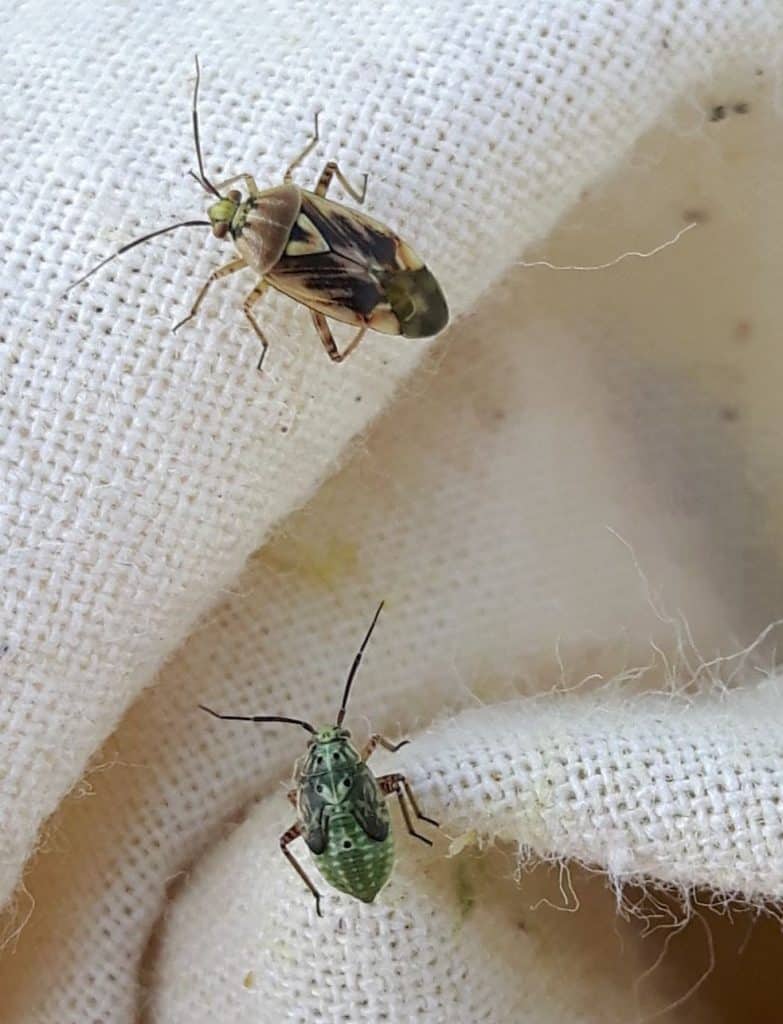Key Result
This study validates a new threshold for lygus in canola. The general pattern is that abundances below two lygus per sweep do not reduce yield. Thus, the threshold of two to three lygus per sweep (20-30 per 10 sweeps) is recommended. Since current canola cultivars appear to tolerate lygus damage better than older cultivars, reducing this threshold as prices of canola increase is not recommended.
Project Summary
Background
Lygus bugs are a sporadic pest of canola at the pod stage from south western to north central Alberta (along highway 2). In the Peace Region of Northern Alberta, some growers are concerned that they pose a risk even at earlier bud and early flower stages. In Saskatchewan they are sometimes a concern in the Meadow Lake area in the northwest and also in southern Manitoba where the thresholds were originally developed.
Insecticide spraying during late flower or early pod is becoming a common practice in some regions but there is no agreement on economic thresholds and limited data for the benefit of spraying at the mid pod stage. Past and current studies in Alberta support the traditional threshold of 1-2 per sweep. However in west central Alberta this threshold is considered too low; in recent years, most fields in this region exceed 2 lygus per sweep. Therefore, applying the current low threshold would result in excessive, potentially unnecessary insecticide sprays with added costs and detrimental environmental impacts on beneficial insects or spiders and pollinators like bees. In addition to lygus, other insects such as flea beetles at the seedling stage in humid sites and cabbage seedpod weevil in southern Alberta require monitoring and potential control actions. Diamondback moth and other Lepidoptera pests may become abundant in some sites and also need monitoring and potential control. All these variables need to be taken into account to explain yield differences between sprayed and unsprayed treatments in field studies.
The purpose of this study was to validate economic thresholds for lygus using commercial canola fields.
Objectives
1) Validate lygus economic thresholds in commercial canola fields.
2) Determine the impact of spraying for other pest insects that may reach nominal economic thresholds (e.g. flea beetles in central/northern areas, and cabbage seedpod weevils in the south.
3) Document landscape features that can influence risk of lygus damage.
4) Survey lygus bugs in canola in Saskatchewan and validate thresholds.
Methodology
This study was completed in southern and south central Alberta from 2016 to 2019 in commercial canola farms with large plots (~25m x 100m). Spraying was done by the farmers and yields were taken from the combine monitors, or weigh wagons and manual quadrats. Thresholds were calculated using average canola prices for 2020 and linear regression of yield on lygus sweep samples. A related farm study from 2010 to 2013 was included in the analysis.
A drought occurred in 2017 and 2018. Fields planted late were favored to attempt to find more lygus. In 2019 a field near Carstairs had nearly 5 lygus per sweep and insecticide application did not reduce the numbers, which may be indicative of insecticide resistance and worth future research.
Results
From 2016 to 2019, 28 farm site-year combinations have been studied.
The main accomplishment of this study is the validation of a new threshold for lygus in canola. Despite large variability at many levels (within a field, between fields and years), there was a general pattern that abundances below two lygus per sweep do not reduce yield. In fact at low abundances below one per sweep yields were on average higher in fields left unsprayed compared to those sprayed at the late flower/early pod stage. This may result from damage caused by ground spraying at the late flower stage or early pod stage or from indirect impacts of the insecticide on beneficial insects like predators. Thus, the threshold derived from a previous cage study of 2-3 lygus per sweep is recommended. Because current canola cultivars appear to tolerate lygus damage better than older cultivars, reducing this threshold as prices of canola increase is not recommended.
A second important finding from this study is that lygus bugs no longer reach pest status in most regions of the Prairies: Manitoba, Saskatchewan and northern Alberta. It appears that pest risk from lygus occurs mainly in a narrow corridor between Edmonton and Lethbridge towards the foothills. The main pest species of lygus are Lygus keltoni with L. lineolaris becoming as prevalent in the more northern portion of this corridor. Furthermore, in the southern portion of this corridor it appears that new cultivars may be less susceptible to lygus damage than older cultivars. Significant yield losses were not observed in the new study (2016-2019) in contrast to a related study done from 2010-2013 where older hybrid cultivars were planted.
Landscape factors affect lygus abundance in southern Alberta. We determined that regions with fewer canola fields could result in higher lygus pest abundance because they concentrate in the fewer fields. This may explain why lygus are less of a problem in the Peace Region area if they are diluted in the vast canola acreages of neighboring fields. Previous cropping history in a landscape had no effect on lygus abundance, which is not surprising given the high dispersal ability of these bugs.
Conclusion
There is no need to spray for lygus at early pod in canola fields that have less than 2-3 lygus per sweep. In fact, at low abundances of 1 or less per sweep, this study suggested that canola yield may in fact be higher in fields not sprayed vs those sprayed at early pod. Following the new lygus threshold will save production costs and protect beneficial insects. Pay close attention to fields isolated from other canola crops that are planted late or have delayed maturity due to some biotic or abiotic stress.






